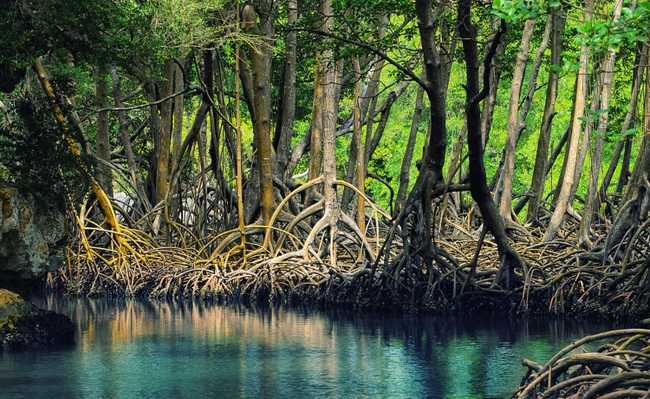Mangroves are allies in combating climate change
Mangroves are estimated to provide ecosystem services valued at US$1.6 billion per year

Mangrove in Los Haitises National Park, Dominican Republic. Photo: WkiMedia (CC)/Anton Bielousov
In a message for the International Day for the Conservation of the Mangrove Ecosystem, celebrated this Friday (26), the director general of Unesco, Audrey Azoulay, recalled that these ecosystems are fundamental both for communities in coastal regions — where mangroves are a source of livelihoods and protection against natural disasters — as well as for the rest of the world, which has an ally against global warming in the mangroves.
“Its complex root systems trap sediment, reduce water flow and store coastal blue carbon from the atmosphere and ocean,” said Audrey.
Blue carbon is carbon dioxide that is stored by oceanic and coastal ecosystems, being absorbed from the atmosphere and converted into biomass, found in living beings and in the environment. With this carbon capture, the seas and coasts help to regulate the volume of greenhouse gases dispersed in the atmosphere.
- What are greenhouse gases
The head of UNESCO also stated that the mangroves "contribute to the stability of the coast, by protecting the coral reefs and preventing erosion caused by waves and storms".
In southern Thailand, the benefits associated with protecting mangroves from storms were estimated at $10,800 per hectare, according to data from the UN Convention on Wetlands. In the Krabi River estuary, mangroves are being reclaimed and planted to protect vulnerable coastal communities from tropical storms and also to counteract the impacts of rising sea levels.
According to research collected by the UN convention, the main cause of the disappearance of mangroves is the transformation of these ecosystems into agricultural areas or areas destined for aquaculture. This form of mangrove destruction is mainly observed in Southeast Asia.
The United Nations Conference on the Oceans points out that around 67% of all mangroves in the world disappeared over the last century, due to the development of coastal regions, aquaculture, pollution and other human activities.
“The protection of mangroves requires innovative scientific solutions and a multidisciplinary approach that encompasses water and environmental sciences, geosciences, oceanography and local and indigenous knowledge systems, all present in the work developed by Unesco,” said Audrey.
The official recalled that, through the creation of biosphere reserves and heritage sites, the UN agency has placed different areas of mangroves under conservation efforts. Examples include the La Hotte Biosphere Reserve in Haiti, the Langkawi Global Geopark in Malaysia, and the Sundarbans World Heritage Site in the Ganges River Delta.
Mangroves are estimated to provide ecosystem services valued at $1.6 billion a year. These services include the natural supply of animals captured for human consumption and participation in the ecological balance of coastal communities.
- What are ecosystem services? Understand
“Mangroves are versatile ecosystems located in tropical estuaries, which form the habitat of numerous amphibian and marine species, provide essential activities and products to human communities around them, and preserve the environment and biodiversity,” emphasized Audrey.
The head of Unesco also stressed that equality between men and women is essential to guarantee the preservation of mangroves.
“Women play a fundamental role in contributing to local and community development in the construction and defense of territories, as well as in protecting and transmitting essential knowledge to reduce the loss of mangroves. Integrating a gender-sensitive approach to our collective conservation efforts is key to mangrove recovery,” added the leader.










